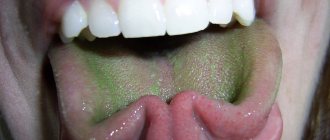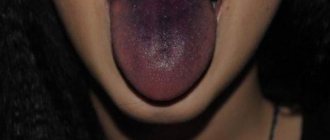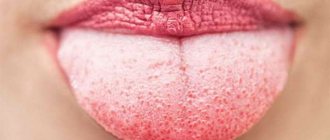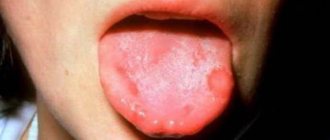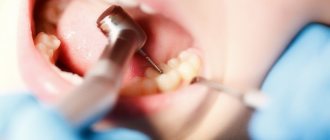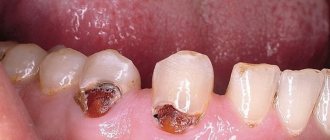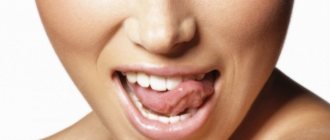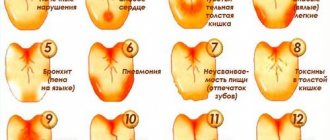Have you been struggling with GASTRITIS and ULCERS for many years without success?
“You will be amazed at how easy it is to cure gastritis and ulcers just by taking it every day...
Read more "
Many people notice a white coating on the surface of the organ, which can be a normal physiological phenomenon, or a sign of a serious pathology developing in the internal organs. If the hygiene procedures carried out do not help eliminate the thick white plaque, then patients should urgently contact medical institutions for consultation.
What is plaque on the tissues of the tongue?
We will divide the reasons for the formation of layering into groups:
- anatomical;
- hygienic:
- medicinal.
The tongue as an anatomical organ of a person is unique in that its mucous membrane is covered with an epithelial cover with formations in the form of papillae. They help us taste food. They are also easily susceptible to the destructive effects of microbes and bacteria. Therefore, epithelial cells become obsolete, peel off, replacing themselves with young cells. But it happens that this process is inhibited by the upper layers of the epithelial membrane, which, during the active change of cells, die, but do not crumble, forming a coating on the tongue.
The cause of plaque is the use of strong antibiotics
Tongue diseases
- catarrhal, ulcerative, desquamative glossitis, “geographical” tongue
With desquamative and “geographical” glossitis, the tongue is covered with a white coating with red spots. Desquamative glossitis is a sign of general dysbiosis and serious systemic diseases of the body. Red spots represent areas where either the epithelium is absent or the altered papillae of the tongue are grouped together. The cause of “geographical” glossitis is not clear; inflammation in the areas of desquamation of epithelial cells is not detected. It is believed that the tongue becomes such a bizarre shape as a result of a genetic disorder.
- galvanic stomatitis
Galvanic stomatitis occurs when there are metal prostheses in the mouth and is manifested by a white coating, spots in the form of pimples, and in severe cases, erosion and burning.
The use of carbolic acid, formaldehyde, antibiotics, sulfonamides, and even substances such as eucalyptol and anise oil found in toothpastes and cosmetics can cause tongue damage.
Types of plaque
A similar phenomenon happens to everyone: both children and adults. We don’t even think about healthy plaque and don’t pay attention to it. It appears more or less depending on the time of year. In the summer, when the period of berries, fruits, and vegetables begins, the layer on the tongue is quite noticeable, since it has different shades:
- white;
- yellow;
- green;
- even dark blue.
In winter, plaque is not visible on a healthy body.
Yellow coating on the tongue occurs due to liver diseases
Why does plaque appear on the tissues of the tongue?
The appearance of dense plaque is often a symptom of a disease in the body. As soon as you notice that your tongue has become coated with a layer of distinctive color, you should be careful.
Thick plaque will indicate chronic diseases and complex infections.
Therefore, it is important to identify the cause of its formation in time. Especially when it comes to the health of the child.
Medical terminology
In medical practice, the following types of plaque stains are distinguished:
- diffuse,
- local.
A diffuse appearance occurs when the entire surface of the tongue is covered with a colored layer. The local type involves the formation of plaque on a specific area of the mucous membrane.
Diffuse plaque covers the entire tongue
In addition, the accumulation can have a different structure: be wet or dry, have a curd-like shape. Soft plaque can be quickly removed by scraping off with a toothbrush or a special scraper. A hard scraper is more dangerous and requires medical intervention.
How does plaque appear on a child’s tongue?
A brown coating on a child’s tongue occurs due to insufficient oral hygiene. It seems that infants cannot have such a problem, because they have no teeth and nothing to brush, but they also need to clean their mouth after breastfeeding. Kids learn to explore the world, so they taste everything, in this way they introduce different microorganisms to themselves.
Medications also provoke the appearance of a bacterial layer.
A newborn in the outside world is not protected from diseases and infections. In especially difficult cases, mothers have to turn to medicinal treatments. As a result, the child may develop an allergy to drugs, pathogenic microflora in the mouth, which reveals itself with a coated tongue.
Treatment methods
Treatment for this category of patients should be selected by specialists.
The chosen technique will be aimed at relieving unpleasant symptoms, as well as eliminating the causes of the development of the pathological condition:
- If the cause of plaque formation is a sweet dish or a white product, then after the meal it will be enough for a person to thoroughly rinse the mouth and clean the surface of the tongue with a toothbrush.
- If the cause is gastrointestinal pathology or infectious diseases, then a drug therapy regimen is selected by an appropriate specialist.
- If the formation of a white coating on the surface of the organ is associated with drinking alcoholic beverages or smoking, then the patient must first get rid of addictions, after which he will be prescribed a detoxification course of drug therapy. It is mandatory for this category of patients to be prescribed medications whose action is aimed at maintaining the functioning of the liver. Measures are taken to restore the water balance in the patient’s body.
- If the reason lies in insufficient oral hygiene, then the patient needs to choose a good toothpaste, rinse, etc.
- If the tongue is covered with a whitish, cheesy film due to thrush, then experts prescribe the patient a course of drug therapy. It will include tablets "Bifiform", "Diflucan", "Clotrimazole", "Amphotericin". The surface of the organ must be treated with special ointments: “Amphotericin”, “Clotrimazole”. For prevention purposes, patients should rinse their mouths after each meal with a personally prepared solution: potassium iodite and 1 tbsp sodium solution 3.0% are added to the water. l. The duration of preventive measures is 1.5 months.
- If the reason lies in pathologies of the tongue, then first of all the cause of their development is identified and eliminated. After this, antiseptic treatment of the oral cavity is carried out using Tantum Verde and Chlorhexidine. Patients are prescribed anti-inflammatory medications, for example, Corsadil and Romazulan tablets. Wound healing agents are prescribed, as well as drugs that normalize keratinization processes. For example, vitamin A, rosehip oil. An antiallergic course of therapy is carried out, vitamin and mineral complexes are prescribed.
Causes of brown plaque
Most often, a newborn's tongue becomes white or yellow. In the first case, it acquires color due to the formation of thrush, but quickly renews and passes. In the second case, the baby may have problems with the liver, which results in jaundice.
Brown plaque is less common and seems to be a more dangerous phenomenon for the child’s health, especially if it appears on the tongue of an infant.
Brown plaque in teenagers is due to hormonal changes
Doctors name the following reasons for a brown tongue:
- Disturbance of gastrointestinal processes, digestive problems.
- A state of dehydration resulting from elevated temperature or low fluid levels in the body.
- Lack of B vitamins.
- Ingestion of fats, food poisoning.
- Reaction to certain medications.
Coca-Cola turns your tongue brown
There is another reason that is not related to the biological nature of the body. This reason is somewhat banal, but it is not uncommon - eating brown foods:
- chocolate;
- caramels;
- soda;
- dark berries, etc.
A change in the appearance of the tongue occurs during the reaction of dyes with the mucous membrane. After all, parents are not always able to control their children’s consumption of foods with dyes. Buckwheat porridge can also leave a dark tint.
Shades of brown plaque
Due to problems with the digestion of the body, the tongue can acquire a brown color of different shades: light brown, yellow-brown and dark brown. When diagnosing a child, the doctor asks to show the tongue and by the shade he can find out the type of disease and its cause.
Layer light brown
A light brown color of the tongue will indicate a problem with the respiratory tract or lymph inflammation.
Digestive problems are the cause of yellow-brown plaque
Layer yellow-brown
The causes of yellow-brown plaque are more related to diseases of the stomach and intestines. The main reasons include:
- Inflammatory processes of the duodenum.
- Cases of bile entering the gastric tract.
- Cases of hepatitis.
- Prolonged dehydration due to vomiting or diarrhea.
A dark brown layer on the epithelium of the mucous membrane indicates that the child may have problems with the kidneys, liver, and gall bladder.
Tooth decay in children can cause plaque on the tongue
If you notice the appearance of a layer of brown plaque in any shade on your baby’s tongue, it is better to immediately consult a doctor.
Black tongue in a child: how pathology manifests itself
Sometimes in medical terminology you can find the term “hairy tongue”.
This is an ugly name for the same black-painted tongue of a child.
But why hairy?
But because in this condition the papillae of the tongue become hyperplastic. This enlargement of filiform papillae can resemble hair, hence the name.
Surprisingly, hyperplasia can be quite large - the papillae increase in length (1 - 2 cm) and width (2 - 3 mm).
Of course, the pathology interferes with the child - changes in taste sensations, dry mucous membranes, itching of the palate, and a gag reflex during conversation may be observed. Sometimes children complain of the sensation of a foreign body in the mouth. The only reassurance is that hairy tongue in children is a rare disease.
Plaque for the little ones
A brown coating on a baby's tongue is a cause of concern, as this is not typical for him. The first and main reason for this phenomenon will be the introduction of complementary foods into food, when the mother’s milk is no longer sufficient. Taking complementary foods is not an easy process for a newborn’s body. He still can't get used to the new nutrients. Brown plaque is the baby’s body’s reaction to supplements.
A newborn's coated tongue may indicate bowel problems and even a lung problem.
But in such cases, mothers should pay attention to the child’s temperature. If a child has a fever and at the same time there is a brown coating on the tongue, it is necessary to call an ambulance in order to provide qualified assistance in a timely manner.
A yellow coating appears in infants with the start of complementary feeding
Examination of a child in the clinic
Self-medication by parents can end in failure. For proper consultation, you should contact your pediatrician, who will determine the cause and method of preventing infection.
It is important to consider the location of plaque on the tongue in newborns. If the accumulation is visible at the tip, this may indicate a problem with the functioning of the lungs, and may be a sign of bronchial disease. If the layering does not disappear within 2-3 days, this may be a manifestation of an infectious disease such as scarlet fever or influenza. In the form of symmetrical spots, it is a symptom of incipient pneumonia. A brown layer in the center of the tongue is a clear sign of a gastrointestinal disease. In the specialized literature, the concept of “geographical” language is found - this is when plaque spots are localized along the surface in different parts. This kind of coating may indicate infection of the baby’s body with worms.
A consultation with a dentist will help identify the cause of the plaque.
Diagnosis of the disease
In a hospital examination, an accurate diagnosis is established after a general and biochemical blood test, an antibody test, a scraping from the mucous membrane of the tongue, and a urine and stool test. Other studies may be needed: ultrasound of the stomach and intestines, respiratory tract, fiberoscopy and gastroscopy, etc.
Chocolate stained tongue
Depending on the detected test results, parents should consult a doctor: gastroenterologist, toxicologist, infectious disease specialist. If a child’s baby teeth begin to erupt or are already clearly visible, then you should definitely show them to the dentist; sometimes the reason is that the baby has carious teeth.
Prevention of brown plaque on the tongue
We have already found out the reasons for the appearance of a brown coating on a child’s tongue. But how can you prevent this symptom? Rules should be followed to prevent all kinds of diseases associated with changes in the color structure of the tongue. These rules are stated by doctors all over the world, and they are also often voiced by the famous doctor Komarovsky. The rules are simple, but must be followed systematically:
- The room where there is a child must always be clean and tidy; the room should be ventilated, the air humidified.
- At the first appearance of a brown plaque, the mother should call a doctor rather than try to cure the symptom on her own (whether using medication or grandma’s folk remedies).
Oral hygiene - prevention of plaque formation
You need to constantly monitor your baby's condition. If you notice a plaque, think about what the child has been given to eat recently, what he has taken, how he is doing with the toilet, and whether he has a fever. If you notice a connection with foods, try reducing the dose for a couple of days or completely removing it from your diet. Then check to see if the natural color of the tongue has returned. The main thing is to establish in time the tendency towards darkening and thickening of the plaque layer.
If your child already indulges in sweets, limit the amount of colored foods: candy, marmalade, soda. All this food has a destructive effect on the child’s body, including the epithelium of the tongue.
Prevention
To keep children healthy and prevent plaque on mucous membranes, parents should follow the following recommendations:
- The rooms in which children are located must be kept clean, constantly ventilated and moistened.
- It is necessary to teach children to take care of their oral cavity. Buy children's brushes for cleaning teeth and tongue and teach them how to use them correctly.
- After eating, rinse your mouth with water or herbal infusions. Breasts should be offered to drink some warm water after feeding.
- Parents need to be attentive to their children’s complaints, pay attention to their appearance and, if signs of illness appear, seek medical help.
- Treatment with antibiotics should be carried out as prescribed by a doctor.
Attentive attitude towards the child will allow parents to distinguish exotic plaque from berries, confectionery, Coca-Cola from symptoms of the disease. Moreover, the latter are always accompanied by additional symptoms (fever, malaise, pain, cough). You should not treat your child yourself. You need to seek specialized medical help.
How to treat brown plaque?
It is difficult to talk about the treatment of brown plaque, since it is not a separate disease, but only a symptom. No doctor will recommend any medications or procedures to cure a coated tongue. It is not the symptom that needs to be treated, but the disease.
The main diseases that manifest themselves with similar indicators include:
- Gastritis.
- Stomach ulcer.
- Infection.
- Weakened immunity.
- Oral diseases.
Only a specialist doctor can make a correct diagnosis and prescribe appropriate treatment. It will identify high-quality antibiotics. It happens that he prescribes a topical medication such as tretinoin. After the course of treatment, the appearance of brown color on the tongue will disappear.
The drug Tretionin is prescribed by a doctor for treatment
Diagnostics
To determine a treatment regimen, it is necessary to accurately determine the cause that provoked the formation of green plaque on the surface of the tongue. To do this, you need to make an appointment with a dentist or therapist.
The diagnostic process includes the following steps:
- Based on the information received, the doctor makes a preliminary diagnosis and refers the patient to a specialist
visual examination of the oral cavity by a doctor, collecting information about the patient’s well-being, what complaints he has (the procedure is carried out in bright light with the study of all surfaces of the tongue);
- analysis of the condition of the tongue, taking into account its shape, color, degree of mobility, humidity (topography and papillae are taken into account);
- the procedure for collecting scrapings of green deposits for the purpose of conducting laboratory research (plaque density, odor, and other criteria are considered).
Additionally, a blood test may be required.
Based on the information received, the doctor makes a preliminary diagnosis and refers the patient to a specialist (dentist, gastroenterologist, mycologist, endocrinologist) to confirm the assumptions and prescribe a course of treatment.
